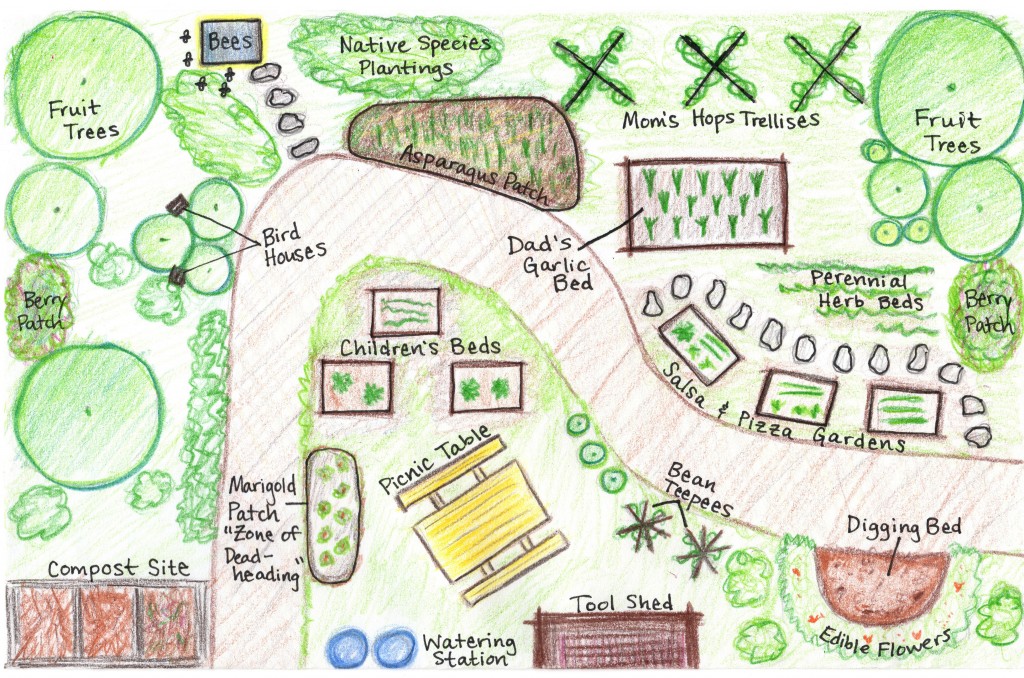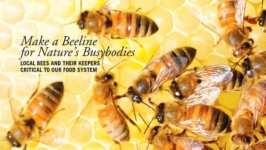Making Gardens a Magical Space
Welcoming kids takes planning, patience
I was at a recent school gardening training, where as part of the “get to know you” activity, workshop participants were encouraged to go around the table and share a childhood gardening memory. I led our table off with a tale of my siblings and I deadheading marigolds (removing spent flowers to encourage new growth) and cracking them open to look at the long, slender seeds. Another participant remembered fondly picking blueberries in her aunt’s yard.
But after the two of us had finished, there was a long, silent pause. One woman finally spoke up and recalled watching the adults work in the garden, but never being invited in to help. She knew from an early age that the fence around her grandmother’s garden was not just meant to keep the deer out, but the grandchildren as well. The other seven adults around the table nodded their heads, and murmured that they had had similar experiences.
Sadly, this is not the first time I have heard from grown-ups who have little or no memory of helping in the garden as kids. And it’s not that gardens in one form or another did not exist around them – for some, certainly, living in a city or other circumstances may have limited opportunities for exposure. Many adults do have memories of eating fresh, homegrown tomatoes from a parent or grandparent’s garden, but not of actually working alongside their relatives to grow this summertime staple. When it comes to actually being in the garden, their childhood memories involve being shooed out of the straight rows and pristine flowerbeds. Of being told don’t touch that, don’t step there, don’t pick those.
It’s unfortunate to hear this tale of exclusion retold by so many adults, since the garden provides so many opportunities for both youth and family learning. Together in the garden, children and adults can plan and problem solve; explore and be curious; and tend to and savor the harvest in a way that only comes from a deeper understanding of the work and growth behind the food they enjoy.
While my father might have lost a few more marigold heads than normal to his young helpers’ eager fingers, allowing us kids to play, explore, and help in our backyard garden never seriously detracted from its aesthetic or productivity. As with cooking and appropriate kitchen behavior, children can be taught how to move and work in around garden plants. Even the youngest gardeners can learn where to step in the garden, and I hear kids in school gardens constantly reminding each other of garden etiquette.
Gardening at home with children is all about cooperating in one space together. By defining specific production, learning and exploration areas – beds that are designated “Mom or Dad’s projects” versus plots where youth can dig to their hearts’ content – boundaries are maintained yet everyone is included. Families can also collaborate on special projects together, assigning age-appropriate tasks. The garden then becomes a place for everyone to work and enjoy the literal fruits of their labor.
Below are a few ideas for creating specific garden spaces, and tips for tending and enjoying the garden with the young growers in your life!
• Give children their own plot or bed! Their interest and commitment will be higher if the plot belongs to them and is their responsibility.
• Start small. Not only for management purposes, but also for the physical size of young gardeners. All points in a youth garden should be reachable by little arms. A 3’x3′ plot is both ergonomic and provides plenty of space.
• Involve children in the planning process. In an age-appropriate manner, allow children to pick what they would like to try growing in their own bed. Keep it to three types of plants for younger children and increase with age, experience and interest.
• Show children how to plant, but allow them to do so on their own. While sharing some of your gardening know-how with kids, it’s important to still let them plant and tend their garden on their own. With first attempts, rows may not be straight and plants might be crowded, but these are all teaching moments for the future.
• Choose reliable plants, but also allow a wildcard. Encourage children to choose easy-to-grow crops like spinach, lettuce, zucchini, sunflowers, beans, and radishes. At the same time, allow young gardeners to pick a more adventurous choice. If the crop struggles, look up potential causes and solutions together.
Space to Explore
For children, the garden can be a natural laboratory and sanctuary all in one. Create spaces for children to dig with disregard, and sit and daydream like kids do best.
• Bug hunts – Turning over rocks and logs to look for insects can make for hours of fun. Create an area where it’s ok for children to roll things over. That way your newly installed flagstone pathway is left unturned.
• Grow a Bean Teepee – Children enjoy having their own “secret” space in outdoor settings, and a simple teepee shape is the perfect support system for growing legumes like peas and beans. Coupling the two adds whimsy to the garden for all ages to enjoy.
• Plan an outdoor playroom – Preschoolers love to plant and re-plant, dig and explore. Create space for the youngest gardeners with containers, pebbles, bark, pinecones, shovels, and other garden-related items to explore with.
Weeding, Watering and Harvesting
• Make tending fun – Create a list together of the things that need to be done to help take care of the garden. Keep each task under 5 minutes for younger kids. If they tire, send children off to explore and play in their own garden spaces.
• Ditch watering cans for cups – Watering is every child’s favorite task. By using cups, adults can control the amount of water going on plants and more children have a chance to water at once. Fill up a bucket with water and have helpers refill their cups by dipping in. Teach children to water “low and slow” with their cups, depositing water right at the root of the plant.
• Plant plenty in your garden, too, for youths to help harvest – Choose large, easy, and fun items to pick like cherry tomatoes, beans, and peas.
Family Garden Projects
• Create a compost pile – Adults who already compost can pass down their wisdom. New to composting? Check out a book and learn together. Teach children about the benefits of recycling our food scraps and what can be composted. Give children the responsibility and task of collecting appropriate items to add to the pile.
• Plant a Pizza, Salsa or Soup – Work together to plant, tend, harvest and enjoy ingredients that can be used together for one of the family’s favorite dishes!
• Grow an Extra Row – Plant an extra bed in the garden and donate the bounty to a local food pantry, soup kitchen, or neighbor in need. Nothing teaches children generosity like sharing food they worked to grow.
Get Your Kids Gardening this Summer, Registration for Wellspring Summer Farm Camps is Open!
At Wellspring Summer Farm Camps, youth learn practical gardening skills while connecting with and where our food comes from, and experiencing how plants grow! Campers will discover what life is like on an organic farm as they try new vegetables and fruits, help with chicken chores, and explore soil, flowers, insects and worms, while playing nature-based games and creating garden-inspired art.
Wellspring Farm Camp offers both one-, three- and five-day sessions to accommodate busy summer schedules. A weeklong resident camp is available for teens. Programs are available for youth ages 6 to 16 and draw families from Milwaukee and the southeastern WI region. For more information and registration forms, visit Wellspring’s website.
Wellspring is a nonprofit education and retreat center as well as a certified organic farm and CSA, whose mission is to inspire and teach people to grow, prepare and eat healthy food.






